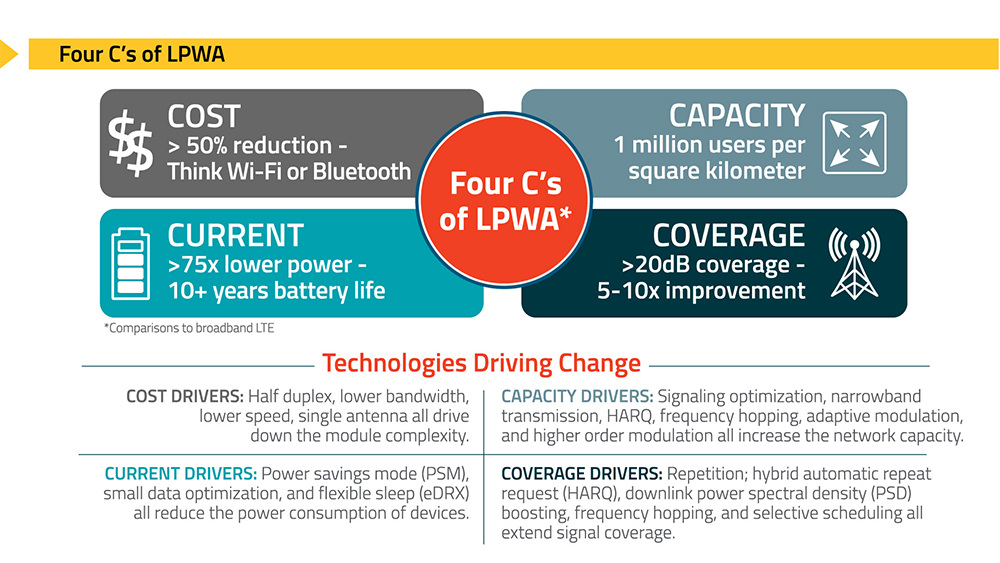If you’re looking to get more involved in the Internet of Things (IoT), cellular IoT connectivity should be the very first technology that you consider. While you might not choose cellular for every IoT application, it is absolutely essential for your IoT strategy.
Cellular IoT connectivity allows companies to scale up quickly, easily and securely, while also providing unique service offerings that may have otherwise not been viable for your company. At its core, cellular technology enables an increased number of assets at the edge, offering you longer battery life and secure, reliable connectivity for all of those devices.
In order to take advantage of this technology, you need to understand how it compares to other solutions currently on the market and how to select the best end-to-end system based upon your specific needs.
How Cellular IoT Connectivity Compares to Other Solutions
When it comes to building the best IoT system for your business, cheaper isn’t always better. You might save some money on the initial installation costs and other overhead fees, but over time, low-cost connectivity solutions could cause you to lose more money in opportunity cost than you saved upon installation. Your choice in technology should always be shaped by your use case and business requirements.
But it can be tempting to choose whatever system happens to carry the lowest price tag for installation and operation. For instance, if you invest in a low-cost solution, you may find that this system is missing certain mission-critical services that you need to run your business effectively. Before you invest in the least expensive options, identify your mission-critical IoT issues, and check whether the alternatives to cellular actually address these issues.
For the most part, many low-cost alternatives to cellular IoT connectivity are popular because they have a great deal of marketing and advertising behind them. While some of these solutions may also be the right choice for certain businesses, many industries will find that cellular IoT connectivity is a wiser option.
Industries that require high levels of bandwidth will need a cellular connection, rather than a low-cost alternative. This is especially true for the entertainment and automotive industries, which require high bandwidth and reliable, fast connections. For these types of businesses, cellular IoT connectivity is really the only solution that will prove to be effective. The best option will depend upon a number of factors.
Before you choose your IoT system, you should ask yourself the following questions:
- Do you have to connect to a network in order to control your system in real-time?
- Are you taking any data from sensors?
- Is your technology available in more than one country?
- Do you need mobility and voice support?
If you answered “Yes” to any of the questions above, then cellular IoT connectivity may be the best solution for you.
LPWA Will Help Grow the Cellular IoT Market Even Further
In the past, it was often considered too expensive to connect devices over cellular networks. But with standards-based Low Power Wide Area (LPWA) technology, companies can easily and cost-effectively use cellular networks. Carriers are making rapid progress with deploying LPWA networks, with many now saying they will deploy both LTE-M and NB-IoT versions of LPWA.
LPWA networks deliver a new class of wireless technology specifically designed for low-power IoT applications—the infographic created by Sierra Wireless below shows you how. LPWA technologies combine lower cost, broader coverage and better battery life with globally available and secure cellular networks ready to connect hundreds of millions more things to the Internet.

In addition to better economics and logistics, if your business uses any sort of tracking technology, you’ll see enormous benefits with LPWA networks. For instance, if you’re tracking shipping containers, longer battery life will mean you don’t have to worry about batteries running out for years. If you’re tracking vehicles in a rental fleet, deep coverage allows you to see where your vehicles are, even in urban canyons. And you can achieve all of this using lower-cost modules and a reliable cellular network.
Beyond tracking, LPWA cellular solutions like this can also improve infrastructure in cities and rural areas, from street lighting, to waste management, to agriculture. In general, any business that works in a smart city or smart agriculture industry will see a huge benefit in a cellular IoT connectivity solution.
How to Implement Cellular in Your Deployment
Once you’ve decided that cellular IoT connectivity is the right solution for your business, you’ll need to ensure that every aspect of your system communicates effectively. For this, you’ll need device-to-cloud connectivity that smoothly integrates your modules, gateways, SIM cards, and cloud platform. This is where Sierra Wireless’ technology can be beneficial for a wide range of industries.
For More Information Contact USAT:
- For your next M2M / IoT project contact a USAT Representative
- For your M2M connectivity needs, use our ExpressM2M service
Share this Post













